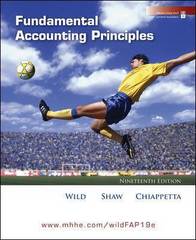Answered step by step
Verified Expert Solution
Question
1 Approved Answer
Which of the following is a financing activity? A. gain on the sale of common stock B. selling short term investments C. buying equipment D.
Which of the following is a financing activity? A. gain on the sale of common stock B. selling short term investments C. buying equipment D. none of the above is a financing activity Which statement is true about the cash flow statement? A. the operations section (using the direct method) starts with net income B. an increase in accounts receivable adds back cash using the indirect method C. the financing section is the same under either the direct or indirect method D. None of the above is a true statement The Fantastic Company purchased 100% of the stock of the Stinky Company. Fantastic Company will record the Stinky assets and liabilities at? A The fair value of the consideration given up by Fantastic. B The fair value of the shares obtained from the owners of Fantastic. C. It depends if we use the purchase or acquisition method D. None of the above is correct Tall Company buys all of the outstanding stock of Small Company on November 1, Year One for $500,000 and is now preparing consolidated financial statements at the end of Year One. Small earned revenues of $10,000 per month during Year One along with expenses of $8,000 per month. On November 1, Year One, Small had only one asseta piece of land with a cost of $300,000 and a fair value of $450,000and no liabilities. The land continues to appreciate in value and is worth $470,000 at the end of Year One. Which of the following statements is true about the consolidated financial statements at the end of Year One? A Consolidated net income will include $120,000 minus $96,000 earned by Small. B Goodwill at the end of Year One is reported as 0 under the acquisition method. C The gain on the land owned by Small is reported as a $30,000 gain D. None of the above statements are true. Held to maturity securities include which of the following? A. Short term trading securities B. Preferred stock in an investee C. A 10 year bond held as investment D. None of the above are held to maturity securities Which of the following is a true statement? A. Amortization of a premium causes the effective rate to be higher than the face rate on held to maturity investments B. Amortization of a premium causes the effective rate to be lower than the face rate on held to maturity investments. C. Since it is an investment there is no need to test for impairment D. None of the above are true statements. Which statement is true regarding trading securities A. Adjustments to FMV is a part of comprehensive income B. Adjustments to FMV flows though the income statement C. Amortization of a discount decreases the carrying value D. None of the above are true statements Cost of available for sale securities include A. Purchase price plus consulting fees B. Purchase price plus brokerage fees C. Gains on sale of securities used to purchase the new securities D. None of the above is a correct answer Which state is true regarding available for sale securities? A. If FMV is greater than cost write up to market and recognize gain as part of operations in the income statement B. Test available for sale securities for impairment C. Subsequent increases in value (after adjusting down for impairment) are allowed D. None of the above statements are true Which FASB is the primary source for accounting for Investments? A. FAS 123 B. FAS 115 C. SAS 112 D. None of the above is the source for the application of investment accounting
Step by Step Solution
There are 3 Steps involved in it
Step: 1

Get Instant Access to Expert-Tailored Solutions
See step-by-step solutions with expert insights and AI powered tools for academic success
Step: 2

Step: 3

Ace Your Homework with AI
Get the answers you need in no time with our AI-driven, step-by-step assistance
Get Started


